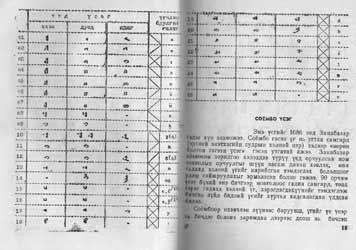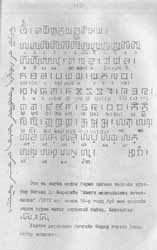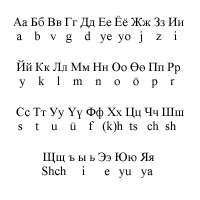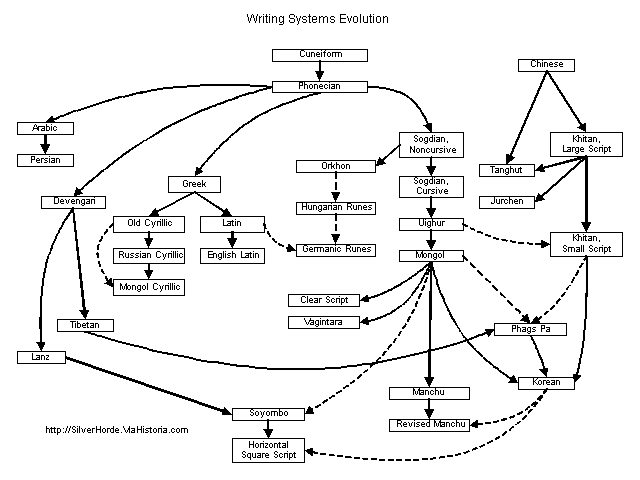

| This phonemic alphabet was adapted in 1204 from the alphabet used by the Uighur tribe at the time. This alphabet has survived numerous attempts at replacement and is still used in Mongolia, as well as Mongol inhabited territories controlled by China and Russia, today. It remains a primary script among Inner Mongolians in China, while Mongolians from other regions primarily use Cyrillic letters but often learn this script as part of their cultural heritage.
For a thorough explanation of the usage of this script, please visit the full article "Writing Mongol in Uighur Script": |
| This script was used as early as the mid 13th century as a stylistic variation of Uighur Script. It is still used in modern Mongolia on occasional signs and books. | |||||||
|
|||||||
 |
Invented in 1269 by Phags Pa Lama for Khubilai Khan, this script was adopted for official documents in the Yuan dynasty. The letters of this syllabic alphabet are based on his native Tibetan script but contain other influences such as being written vertically like the Uighur Script and grouped into syllables like Khitan Small Script. This script was intended to be a universal script for all languages spoken in the Mongol Empire including Mongol, Arabic, Tibetan, Chinese, Sanskrit and Turkic. It did not replace the traditional writing systems of the respective peoples and ceased being used in 1368 with the fall of the Yuan dynasty. Also transcribed "hPags-Pa". | ||||||
|
|||||||
|
More information about Phags Pa: http://www.proel.org/alfabetos/mongolpa.html http://www.omniglot.com/writing/phagspa.htm Phags-Pa font: http://www.valdyas.org/conlang.html |
|||||||
| This alphabet, developed in 1648 by Zaya Pandit Namhaijamts (1599-1662), was intended mainly for Oriat but also for Mongol, Samgard, Tibetan and Sanskrit. This is based on the Classical Mongol Script with ambiguous letters, such as 'O' and 'U', differentiated to be more clear cut. This was used by Oirats in the region between the Ijil River, Ezen River and Kökö Lake. It is still used today by Oirats in Shinjaan. | |
 Figure 6. Clear Script 4 |
|
 |
This syllabary was developed by (Buddhist) Saint Zanabazar in 1686. The name means "Self developed Holy Letters" in Samgard. It was intended to accommodate Mongol, Samgard, Tibetan and for transcribing foreign words. It is typically written from left to right but can be written from top to bottom. Soyombo never widely caught on because it was too difficult to use. Though it has seen some regular use in official capacities such as official seals. It also became a focus of national pride under Bogd Khaan. It's most lasting legacy is the initial symbol of the script being incorporated into the flag of Mongolia. Though this symbol has its origins before this script's invention, it is now called the "Soyombo" symbol. 90 of the 96 letters are shown below. | ||||
|
|||||
|
More information about Soyombo: http://www.mojio.net/soyombo/jkwe.html http://www.omniglot.com/writing/soyombo.htm Soyombo font: http://www.geocities.com/jglavy/asian.html |
|||||
|
|
Another syllabary developed by (Buddhist) Saint Zanabazar around the same time as Soyombo. It contains some influence of the Korean Script (Hunmin chong'um). It is written from left to right and can be used for Mongol, Samgard and Tibetan. Since its rediscovery in 1801, it's actual usage remains unknown. |
 Figure 9. Horizontal Square Script 6 |
|
 |
This alphabetic script was developed in 1905 by a Buryat monk named Agwan-Dorji (1850-1938) as a variation of Uighur Script with less ambiguity. A notable change in this alphabet is that the letters no longer have three different forms. Rather a single form, based on the Medial of the Old Mongol Script, is used regardless of position in the word. The name of this script is based on the Sanskrit translation of the inventor's first name. It was intended to accommodate transcribing Russian words as well. Its use is limited to about ten books printed until 1910 when financial problems prevented him from continuing to promote the alphabet. | ||||
|
|||||

Before the 13th century, Mongolian was not a written language. So when documents needed to be written in the early days of the Mongol Empire, they were done so by administrators, incorporated into the Mongol domain from neighboring cultures, who used their native writing systems. Chinese were among these administrators, and documents such as "The Secret History of the Mongols" were written phonetically in Chinese logograms. There are, perhaps, some 500 characters that actually comprised the syllabary used for this purpose.
This section covers the other major Ural-Altaic nomadic and semi nomadic tribes from Central Asia. Where known, the examples still spell "Mongol", or its closest equivelent, for a direct comparison with other scripts.
Protomongolian Script ?
Övög Mongolchuudin Üceg Bichig ?
Hun / Hsing-nu:
Stamp Letters
Tamgaa-üseg
A pictoral, possibly logographic script, used for this Uralic language was found in caves in the Govi-Altai Aimag by Prof. Rinchen as well as on about 60 to 70 Hun Tombstones.
Tibetan:
A syllabic alphabet created for this Sino-Tibetan language in the 7th century by Thon-mi Sambhota based on Devanagari and still in use today.
http://www.omniglot.com/writing/tibetan.htm
Uighur:
Uighur is a Turkic language still spoken in Central Asia which has used several different alphabets over the centuries all derived from alphabets of people they traded with towards the Middle East.
|
| Earliest writing system for a Turkic language, early 8th century, and derived from noncursive Sogdian. Letters are written from right to left or bottom to top. Some theories argue that Orkhon is directly related to Hungarian and Germanic Runes. Replaced in the 9th century by Uighur Script. |
|
http://www.omniglot.com/writing/orkhon.htm Orkhon font: http://www.tonyukuk.com/Orkun.ttf | |
|
|
Developed in the 9th century, derived from cursive Sogdian. It was the basis for the Mongolian Script, sometimes known by the same name. |
|
http://www.proel.org/alfabetos/uigur.html | |
Khitan: (Liao dynasty 916-1125, Khara Khitai - Marco Polo's Cathay)
Large Script and Small Script
Ihe Bichig and Bagha Bichig
An extinct Altaic language, probably from the Mongolic branch, that used two scripts simultaneously, referred to as "Large Script" and "Small Script", developed in 920 and 925 respectively.
The former is a logographic script based on Chinese characters, and the latter, developed by a Khitan scholar named Diela, is a syllabic script influenced in part by Uighur with characters for each syllable combined into word groups.
Used until 1191.
http://www.ancientscripts.com/khitan.html
http://www.omniglot.com/writing/khitan.htm
Tangut:
Developed by Teacher Iri in 1037 and used until the 16th century for an extinct Sino-Tibetan language known as Hsihsia. Uses logographic characters loosely based on the Chinese and Khitan scripts.
http://www.omniglot.com/writing/tangut.htm
Jurchen: (Jin dynasty, 1115-1234)10
|
|
Jurchi Script / Southern Tungusic Developed by Wanyan Xiyin in 1120 and somewhat based on Khitan. This also had a Large Script and Small Script with the latter developed in 1138. Used for this Tungusic language until at least 1413. |
|
http://www.ancientscripts.com/jurchen.html http://www.omniglot.com/writing/jurchen.htm http://www.jurchenlanguage.com/ | |
Manchu: (Tai Ch'ing or Qing dynasty, 1644-1911)
Manj Bichig
|
| Created in 1599, this syllabic alphabet was derived from the Classical Mongol Script for this Altaic language of the Tungusic branch. This script was modified in 1632 with influence of the Korean Script (Hunmin Chong'um). It continued to be used after the fall of the Tai Ch'ing dynasty in 1911. There are now about twenty one thousand fluent speakers of Manchu remaining. |
|
http://www.omniglot.com/writing/manchu.htm http://www.proel.org/alfabetos/manchu.html | |
There were many other scripts utilized in the Mongol Empire for languages spoken by people in their domain. These include Indo-European languages such as Russian, Bulgarian, and Armenian in addition to languages of other families such as Georgian and Hungarian/Magyar. A detailed review of these languages and their corresponding scripts is beyond the scope of this article. There is, however, one script that is worthy of mention in this context.
Korean
Hunmin Chong'um (Korean name)
The modern Korean Script named Hunmin Chong'um, which can be translated as "The Correct Sounds for the Instruction of the People",
is a phonetic alphabet with letters of each syllable grouped into a character referred to as a "Syllabic Unit".
It was invented in the reign of King Sejong The Great (1397-1450), the fourth king of the Choson dynasty (1392-1910).
The Korean language is loosely considered an Altaic language much the same as Japanese.
The Korean Script contains elements of most East Asian scripts including Khitan Small Script, Mongol Script, Phags Pa Script, and Tibetan.
It has also influenced scripts such as Manchu and Horizontal Square Script.

Writing Systems Evolution

Writing Systems Spread

2 From Mongolin Khuuchin Bichgiin Tsagaan Tolgoi Zov Bichih Dürem.
3 From Mongolin Khuuchin Bichgiin Tsagaan Tolgoi Zov Bichih Dürem.
4 From Mongolchuudin Üseg Bichig, Üg Hellegiin Tüüh Garlaas.
5 From Mongolin Khuuchin Bichgiin Tsagaan Tolgoi Zov Bichih Dürem.
6 From Mongolin Khuuchin Bichgiin Tsagaan Tolgoi Zov Bichih Dürem.
7 From Mongolchuudin Üseg Bichig, Üg Hellegiin Tüüh Garlaas.
8 Information in this section based largely on the corresponding links, primarily Omniglot. Except for the section on the Hun which is from Mongolchuudiin Utgha Soyoliin Tovchoon.
9 The example here spells "Uighur" instead of "Mongol". As this is the same alphabet as the initial example in this article, here is compared a diffferent word. Note the spelling U - i - i - gh - u - r to distinguish U - i from Ü.
10 Jurchen script for Monggu (Mongolians) from Vocabulary-Personal section of JurchenLanguage.com.
Batbayar, Jalair. Mongol Uran Bichlegiin Tuuh. Ulaanbaatar: Interpress Hevleliin Kompanid Hevlev, 2001 (ISBN 99929-70-46-4)
Calvo, Wenceslao. Alfabetos De Ayer Y De Hoy. 1999.
http://www.proel.org/alfabetos.html (1 October 2002)
Choijilsüren, D. Mongolin Khuuchin Bichgiin Tsagaan Tolgoi Zov Bichih Dürem. edited by Kh. Luvsanbadlan, G. Nasanbuyan & J. Amgalan. Ulaghanbaghatur Khota, Mongolian People's Republic: Academy of Science Publisher, 1978 (no ISBN)
Cleaves, Francis W. The Secret History of the Mongols. Cambridge; London: Harvard-Yenching Institute, 1982 (ISBN 0-674-79670-5)
Golden, Peter B. The King's Dictionary. The Rasulid Hexaglot: Fourteenth Century Vocabularies in Arabic, Persian, Turkic, Greek, Armenian and Mongol. Leiden; Boston; Köln: Brill, 2000 (ISBN 90-04-11769-5)
Jurchenlang. JurchenLanguage.com. 2002.
http://www.jurchenlanguage.com (1 October 2002)
Kapaj, Luigi. Writing Mongol in Uighur Script. 2002.
http://www.ViaHistoria.com/SilverHorde/research/UighurScript.html (1 October 2002)
Katsiavriades, Kryss. KryssTal: Languages and Linguistics. 2002.
http://www.krysstal.com/language.html (1 October 2002)
Lo, Lawrence K. AncientScripts.com. 2002.
http://www.ancientscripts.com/ (1 October 2002)
Luvsanbaldan, Kh. & Ts. Shagdarsüren. Mongolchuudin Üseg Bichig, Üg Hellegiin Tüüh Garlaas. edited by Ts. Ölziihtag. Ulaanbaatar: Center for Language Publishing, 1986 (no ISBN)
Poppe, Nicholas. Mongolian Language Handbook. Washington, D. C.: Center for Applied Linguistics, 1970 (ISBN 87281-003-8)
Shagdarsürüng, Tseveliin. A Study of the Relationship Between the Korean and the Mongolian Scripts. Mongolian Studies, Journal of the Mongolia society, Vol XXV. pp.59-84. Bloomington, Indiana: The Mongolia Society, 2002 (ISBN 910980-95-0)
Shagdarsuren, Tseveliin. The Mongolian Language and Scripts. 1999.
http://www.indiana.edu/~mongsoc/mong/language.htm (1 October 2002)
Shagdarsüren, Ts. Mongolchuudiin Utgha Soyoliin Tovchoon. Ulaanbaatar: Erdem Company, 1991 (no ISBN)
© 2002-2003, by Luigi Kapaj, in the SCA: Gülügjab Tangghudai (Puppy)
Send comments to Puppy@ViaHistoria.com
return to the Silver Horde home page.
